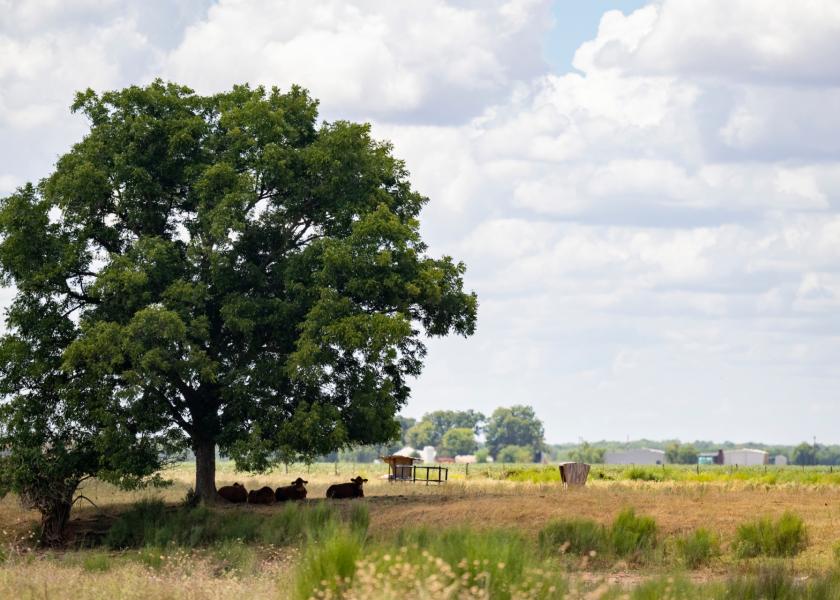Strategies For Drought Management on Pastures

During a drought, little can be done to increase forage pasture growth. Proper management, however, can minimize impacts when drought does occur, according to a Texas A&M AgriLife Extension Service forage specialist and Texas A&M AgriLife Research agronomist.
Vanessa Corriher-Olson, Ph.D., Overton, and Jamie Foster, Ph.D., Beeville, said careful management early in a drought can minimize long-term stand damage and help maintain forage yields when rains do come.
If pastures are managed properly during times of low moisture, the effects of drought will be less severe and pastures will rebound faster when precipitation is sufficient, they said. Management practices that minimize damage to pastures during drought are also the same for maintaining healthy pastures in a normal year.
Pasture management practices and guidelines
Corriher-Olson and Foster outlined some key areas where proper management can make a difference.
— Managing livestock: Reduce stocking rates if forage supplies are limited. First, cull cows that are old, open, in poor condition or have poor disposition. A veterinarian can palpate cows for pregnancy and check for health problems that warrant elimination from the herd. Cows that are not pregnant are difficult to justify feeding expensive hay or grazing. Moving cattle to leased grazinglands where forage is available is an option to relieve stressed pastures without selling off a portion of the herd.
Another option is early weaning and sale of calves. This reduces the stocking pressure and the nutrient requirement of the cows — reducing forage intake by 20% — because the heavy nutrient demand of lactation is stopped. The longer that decisions to decrease livestock numbers are delayed, the sooner the forage supply will be exhausted. Delaying the decision to reduce stocking during a drought accelerates financial losses of the livestock production enterprise.
— Grazing management: Lack of moisture suppresses plant growth and retards root development. Allow 6-8 inches of new growth before allowing livestock to graze. A healthy improved pasture will have 3-4 inches of stubble. In severe drought, pastures may not reach this stubble height, so these pastures should be deferred until the time of dormancy, when nights are 55 degrees for warm-season grass pastures, and then grazed to 3-4 inch stubble height.
Those pastures with little or no green growth are living off the roots, and root mass has declined substantially. Roots must be replaced, or bare areas will increase, and invader grasses/weeds will prevail. In addition, overgrazing plants removes the buds needed for re-growth. If insufficient stubble and root remains, water capture and infiltration is reduced. So, when it does rain again, less water will enter the soil stores for plant growth.
Stocking rates must be reduced on all types of forage. Fertilizer inputs should be reduced or stopped during periods of prolonged reduced precipitation, and deferred grazing should be considered to increase harvest efficiency, forage utilization and flexibility of herd management.
— Weed management: Think twice before applying herbicides during a drought. Plant mechanisms in response to a drought will prevent adequate entry of herbicides into plants and result in a high-cost application with little control of the specific weed.
Preparing for the next drought
Some best management practices can prepare pastures and hay meadows for a potential drought: forage management, grazing management, weed control and utilization of warm-season annual forages.
— Forage management: It’s always important, drought or not, to pay attention to plant nutrient requirements. Test the soil and apply the recommendations. Ensure soil pH is adequate to enhance fertilizer uptake efficiency. Applying nitrogen fertilizer just prior to times when conditions are likely to be optimum for forage growth, such as the beginning of the growing season, helps to maximize its utilization.
In periods of limited soil moisture, delaying fertilizer application until moisture is present or imminent can also increase efficiency. When rain falls, pastures should be fertilized and ready to grow. If not managed properly during drought recovery, invasive species will establish and be difficult to control or eliminate.
— Grazing management: Heavy grazing during drought can severely stress plants. Even prior to a drought, heavy grazing reduces the root mass and can make the plants less efficient at utilizing any nutrients and moisture in the soil. It may be necessary to remove livestock from pastures and use stored feed for some time. Those without adequate facilities may have to establish a sacrifice paddock where feeding can take place.
Using some method of deferment or rotation stocking management system allows flexibility for this practice. Using a sacrifice paddock will limit the damage to only one pasture as opposed to multiple areas. Animals could also be fed in alleyways and/or lanes.
If feeding livestock in other locations, make sure water is always available. If destocking has occurred due to a drought, consider maintaining herd size at that number. It is much more economical to harvest hay from excess forage during sufficient growth than it is to feed stored forage and supplement during a drought.
Managing for drought is complex and must take place throughout the calendar year. Be sure to graze properly in the summer and plan ahead for fall, winter and spring forage production so that feeding of expensive hay or supplements is minimized.







